H. A. Moyer (automobile)
 | |
| Automobile Manufacturing | |
| Industry | Automotive |
| Genre | Touring Cars, Runabouts, Special Bodied Vehicles |
| Fate | Discontinued Auto Manufacturing. Incorporates (H. A. Moyer, Inc.) and becomes dealer for Stearns-Knight and Velie (automobiles) |
| Founded | 1908 |
| Founder | Harvey A. Moyer (1853–1935) |
| Defunct | November, 1915 |
| Headquarters | Syracuse, New York, United States |
Area served | United States |
| Products |
vehicles Automotive parts |
| Owner | Harvey A. Moyer |
Number of employees | 600 |
| Parent | H. A. Moyer Carriage Company |
H. A. Moyer Automobile Company (1908–1915), a manufacturer of luxury automobiles in Syracuse, New York, was founded by Harvey A. Moyer (1853–1935) of Clay, New York.[1] The company began business in 1876 in Cicero, New York, as H. A. Moyer Carriage Company. As the era of the horse-drawn carriage came to an end, Moyer switched assembly to motor vehicles, although he still produced carriages for some time after that.
History
In 1867 Harvey A. Moyer began his career installing water pumps in the village of Bridgeport, New York, with his partner, David H. Brown of Main Street who operated a wagon and cutter factory. The partnership continued for some time until Moyer moved to Cicero, New York, and established manufacture of the Moyer Carriage.
Moyer later moved his factory and equipment to Syracuse where he became nationally known as the "father of the Moyer Carriage." He achieved fame and a substantial fortune which he used to establish an automobile enterprise in 1908.[2]
As a side business, Moyer owned 158 acres (0.64 km2) in Liverpool he named Moyerdale which was also known as Moyer Farm on the old plank road where he raised Holstein cattle. Another business enterprise he touted offered sire services for his stock that he named Moyerdale Herd.[3]
Carriages and wagons
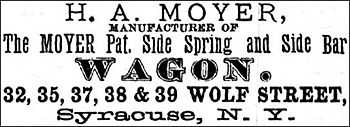
H. A. Moyer Carriage Company began business as a manufacturer of carriages and wagons.[4] The first Moyer Carriage Shop was established in 1876[5] and grew to national prominence as a manufacturer of "fancy carriages," many with the "fringe on top."[6]
The original shop was on the Moyer Farm which consisted of several 100 acres (400,000 m2) on Old Liverpool Road. Subsequently, there were another two shops opened; one on Park Street in Cicero, New York, and the other in North Syracuse, New York, where 500 men were employed .[6]
In 1884, the company was a manufacturer of the "Moyer patented side spring and side bar wagon" and were located at 32, 35, 37, 38 & 39 Wolf Street.[7]
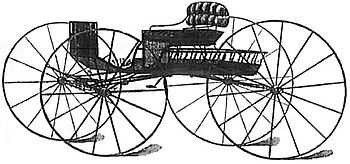
By August 1890, the company advertised their carriages as both "pleasure or business wagons". At that time, the company was located on Canal Street in Syracuse.[4]
Moyer built fine carriages, many of which were shipped to South America and Europe. They had a reputation as a luxury carriage builder and the company prospered.[8]
The company manufactured over 200 different styles of carriages.[9] A 1907, "farm implement buyer's guide" noted that the company made a variety of vehicles including; Cabriolets, Reach wagons, Concord wagons, Democrat wagons, Road wagons, Buggies, Runabouts, Buckboards, Stanhopes, Surreys, Bike carts and High-wheel speed carts.[2]
Moyer had many competitors in the Syracuse area including; Bradley & Company, George M. Brown & Company, Lee, Cowan & Bowen Company, Penn & Lee and Howe Spring Wagon Company in East Syracuse.[10]
Moyer was still manufacturing carriages in 1916.
Automobiles
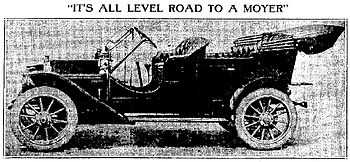
The company later opened an automobile-manufacturing factory and changed their name to H. A. Moyer Automobile Company. They produced sedans and touring cars between the years 1908 and 1914.[11] A six-cylinder touring car cost $3,250 and a four-cylinder was $2,500.[11]
The first cars had a water-cooled, T-head engine and were produced with both runabout and tudor touring car models. By 1912, the company was producing six-cylinder, four-door touring cars.[12]
Over the years, approximately 100 automobiles were built every year, not exceeding 1,000 total.[8] The company headquarters were located at the corner of Wolf and Park streets in Syracuse.[13]
The company was run by father and son, H. A. Moyer and Bert W. Moyer (1873–1935).[14] The founders believed that they sustained in the manufacture of automobiles the reputation made by the company years earlier, when a Moyer Carriage meant the "best carriage that could be made".[15]
The Moyer automobile first appeared in newspapers across the country in 1911 and was announced with much formality, such as this quote from the Lowell Sun that talked about "out-of-town cars";
"The Moyer manufactured by H. A. Moyer, the celebrated carriage builder, is the result of 35 years of experience in the manufacture of high grade vehicles for pleasure use and combines all of the valuable features of that experience as to fine qualities, thorough proportion, elegant finish and design, together with thorough attention to every detail of construction. "[16]
In the first five years of business, close to 500 Moyers were sold. Moyer customers came from all over the United States. The automobiles came in "all colors", and the famed cartoonist Tom Powers ordered a "gaudy" one of robin's-egg blue.[12]
The latest model in 1913 was a two-passenger roadster equipped with a 4½ by 5-inch (130 mm) motor, combination electrical self-starter, ignition and a lighting device. According to Moyer engineer M. Power, the new motor developed 12 percent more power at 1,000 feet (300 m) per minute piston speed than the S.A.E. rating, while the maximum horsepower was developed at a piston speed of over 1,600 feet (490 m) per minute.[17]
Like most new car manufacturers of the day, H. A. Moyer discovered that participation in auto shows was a good marketing tool and provided much needed mention in local newspapers. The shows were also a good place to show off the newest models with the latest technology. The Moyer exhibit in the 1915 Syracuse Automobile Show included a new six-cylinder touring car, a four-cylinder touring car, roadster and chassis.[15]
Automobile hearse
Moyer produced the first automobile hearse and sold it to Fairchild and Fancher. The company also manufactured the police department's first motorized morgue wagon.[11]
Company mottos
Harvey A. Moyer was known for his wit and catchy phrases he devised to advertise his vehicles, including "No Hills too steep, no sand too deep, all roads are level for a Moyer."[12]
Terms of sale
Moyer had very specific terms of sale for their customers by 1909;
"STRICTLY Three Months. Positively no goods on consignment. No goods will be sent from factory except on a bona-fide sale. Positively no open accounts. Goods must be settled for by note or acceptance within 30 days from date of shipment. All bills not settled for within 40 days will be subject to three months' draft, dating from date of shipment. When purchasers are unknown to me, or without satisfactory rating, I will ship the goods in my own name and draw at sight, with endorsed bill of lading attached, providing money is advance to pay freight both ways.
I obtain the best rates possible for my customers, but do not in any case guarantee them or allow overcharges to be made to me or deducted free of charge on board of cars at Syracuse, N. Y., and shipped in good order. I do not insure safe carriage or delivery. In case of overcharge or delay in transit, the purchasers' recourse is on the carrier.
In ordering, be sure and state the width of track desired, otherwise, where no track is mentioned, New York track, 4-8, will be sent."[18]
Moyer patents
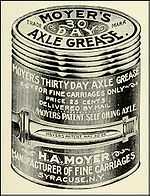
Harvey A. Moyer applied for several patents on various devices between the years 1882 and 1898.[1] The company marketed a number of products to consumers and other companies and Moyer continued to expand their product line. A 1909 company catalog advertised items such as Moyers 30 Day Axle Grease which was "for carriages only."[18]
The Moyer Noiseless king bolt patented on December 13, 1898 was considered "one of the greatest improvements to the old style clip king bolt" because it solved problems with the old bolt style "getting loose and rattling."[18]
Moyers also sold a self oiling axle which was patented on May 23, 1899. It was advertised as the "only absolute perfect self-oiling axle, which distributes its oil the entire length of the spindle without any opening through the axle to weaken it and cause it to break."[18]
A patent was obtained on February 25, 1896, and again on November 29, 1902, by H. A. Moyer for an "improved" Hub boring machine. According to the Moyer product catalog for 1909, 400 of the machines were in use by the largest carriage builders of the world. The company stated that the machine did the work "perfectly" and guaranteed to do it twice as fast as any other machine and that "No factory making 500 jobs can afford to be without it."[18]

Moyer factories
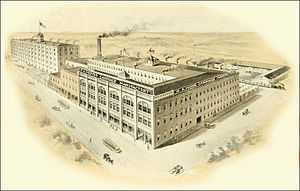
The H. A. Moyer company occupied a large complex containing at least four buildings which were bordered by North Salina Street on the south, Wolf Street on the east, Hiawatha Boulevard on the west and Carbon Street to the north. The complex is split in half by Park Street.
In November 1909, the company was finishing a new automobile plant at Wolf and Park streets and had occupancy of 100 employees on January 1, 1910. The company planned to produce 200 cars that year and the "working force will be increased by degrees with that end in view." The site and buildings represented an investment of $50,000. The main building was 150 feet (46 m) by 60 feet (18 m) and four stories tall and a secondary building was 117 feet (36 m) by 30 feet (9.1 m) and one story. Both buildings were constructed out of brick. The company had vacant land adjourning the property that was planned for future construction.[19]
The automobile plant was situated with main entrance facing Wolf Street on the east with Park Street on the south and Hiawatha Boulevard on the west. Due north is Carbon Street. A through street depicted on the 1915 postcard situated on the north side of the building (right) appears to be a driveway, not a street. This building was designed by prominent Syracuse architect, Ward Wellington Ward (1875–1932). The Moyer plant was one of the few commercial buildings Ward designed as he preferred to concentrate on the design of family residences.[20] Harvey Moyer's daughter, Maude Moyer (died 1961),[21] was married to Ward.[9]

The carriage plant main entrance faced Wolf Street on the east with Park Street to the north and North Salina Street on the south and Exchange Street on the west which split the block bordering Hiawatha Boulevard, also on the west.
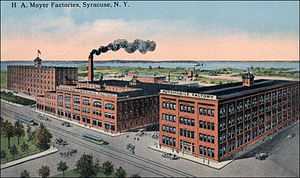
The third building appears in the sketch below (on the left) from 1909 and was a one-story facility located to the west behind the carriage plant on Exchange Street.[18]
The fourth building, built in 1880, now known as the Moyer building, was the first building constructed by the company and was originally used as a carriage factory by H. A. Moyer. The building is a famous landmark in Syracuse. It is located at 1710 North Salina Street with main entrance facing south and is cornered by Exchange Street on the west, Wolf Street on the east, and Park Street on the north.[22]
The 220,000-square-foot (20,000 m2),[9] five-story building is unique not only because of its age and red-brick design, but also, a red Victorian house sits on top of the factory. It was a local mystery for years because no one knew why the house was up there. According to the Moyer family who were interviewed by a daily newspaper in 1937, the 2½ story, 25 square feet (2.3 m2)[9] house was designed as an "architectural gimmick" and was never inhabited. It contains elevator machinery and rafters. It reportedly also held a water tank at one time.[22]
The house was called the "pioneer penthouse" by the Moyer family.[11] Daughter Maude was interviewed in 1937 and told a story about how her father "was known to hoist one of his wagons onto the bungalow roof to show off the company line."[23]
A postcard of the facilities (see below) clearly shows that all four of the buildings owned by Moyer had Victorian homes perched on top. It is not known what happened to the homes situated above the two Wolf Street buildings.

The surrounding area was at one time in the heart of the village of Salina which joined with the village of Syracuse in 1848 to form the city of Syracuse.[24] Onondaga Lake is located to the west of the manufacturing complex.
On August 25, 1898, while H. A. Moyer Carriage Company still occupied the building, it was damaged by the "awful fury of a storm" which was described as a hurricane in the daily newspaper. The roof of the C. H. Fisk's rag factory in Park Street was completely torn off and hurled through the air with terrible force for a distance of nearly 200 feet (61 m), striking the carriage factory at the corner of Park and Wolf streets. The factory walls "staunchly withstood the force of the impact, and beyond the shattering of several windows, no damage was done."[25]
In July, 1914 the company advertised used cars in the classified section of the local newspaper and sold them from the Moyer Automobile Factory on the corner of Park and Wolf streets. In addition to Moyer cars, they also advertised Case, National, Stevens-Duryea and Oldsmobile. Touring cars were the popular model of the year.[24]
Employees
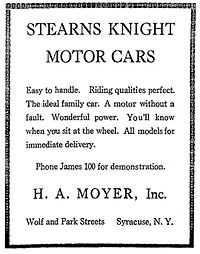
When the new plant on Wolf Street was opened in January 1910, the company employed 100 men.[19] At one point in the early 1900s, the company had 400 to 500 workers at the plant. The firm was the "mainstay in the economy of the North Side at the time."[8] In 1912, there were 285 employees working for the company.[12]
Building occupants
By early 1953, Porter-Cable manufacturing, a company in the business of producing portable power tools and belt sanders, employed more than 400 people in their plant at 1714 North Salina Street, originally the H. A. Moyer carriage factory.[24] The toolmaker bought the original factory from the Moyer family.[9]
The building at 1710–1720 North Salina Street was occupied by the Penfield Manufacturing Company, a manufacturer of mattresses, however, the company closed in 2005.[22] Penfield started making mattresses in 1893. They were located on South Franklin Street in Armory Square for over 60 years and purchased the Moyer Building from Porter-Cable in 1958 and operated there for 48 years.[9]
End of production
The Moyer was built so well and expensively that it could not be sold at a profit. It had features "too fine" for the appreciation of the average motorist including porcelain-finished cylinder blocks that "literally sparkled when the hood was raised." As a result, the company could not adapt to mass production.[26]
H. A. Moyer becomes a dealer for Stearns-Knight and Velie Automobiles
Following the end of Moyer car production, Moyer became a dealer for Velie Automobiles and Stearns-Knight automobiles. Stearns-Knight operated for only a short period before merging with Willys-Overland.[6] During the period of handmade cars, the competition from new plants in Detroit, Michigan, and Buffalo, New York, was too tough and Moyer was forced to liquidate the business. He later made an attempt to produce typewriters, but the effort did not succeed.[8]
The closing of the plant caused considerable suffering in the city's First Ward because of the resulting unemployment.[8]
Advertisements
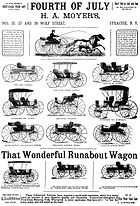 Moyer Carriage Company Advertisement - Fourth of July - June 29, 1887 |
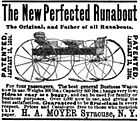 Moyer Carriage Company Advertisement - The American agriculturist, Volume 46, 1887 |
 Moyer Carriage Company Advertisement - The Gazette and Farmer's Journal, Baldwinsville, New York, August 20, 1890 |
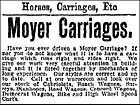 Moyer Carriage Company Advertisement - Boston Daily Globe, Boston, Massachusetts, June 11, 1899 |
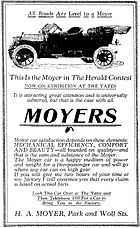 Moyer in a Herald contest - Syracuse Herald, February 11, 1912 |
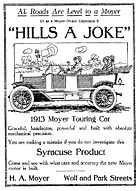 A 1912 H. A. Moyer Advertisement - Syracuse Herald, August 11, 1912 |
 A 1912 H. A. Moyer Advertisement - Automotive Industries, Volume 27, 1912 |
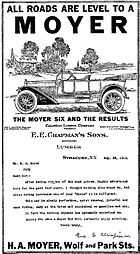 All roads are level to a Moyer, 1913 |
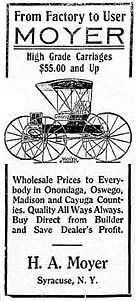 A 1916 H. A. Moyer Carriage Advertisement - Marcellus Weekly Observer, June 16, 1916 |
References
- ↑ 1.0 1.1 "Directory of American Tool and Machinery Patents". Datamp, 2003–2010. Retrieved 2010-08-02.
- ↑ 2.0 2.1 "History of Bridgeport". Rootsweb, 2010. Retrieved 2010-08-02.
- ↑ Holstein-Friesian register, Volume 27, Part I. Frederick Lowell Houghton - 1909. Retrieved 2010-08-07.
- ↑ 4.0 4.1 "Moyer's Patent is the only "Banner" Spring Wagon Made". The Gazette and Farmer's Journal (Baldwinsville, New York). August 20, 1890.
- ↑ "Designer builder, high grade carriages". Rootsweb, 2010. Retrieved 2010-08-07.
- ↑ 6.0 6.1 6.2 "Moyer Antiques to Go on Sale". The Post-Standard (Syracuse, New York). July 16, 1961.
- ↑ Boyd's Syracuse City Directory 1884. Andrew Boyd, 1884.
- ↑ 8.0 8.1 8.2 8.3 8.4 Ganley, Joe (October 6, 1985). "Moyer: Cars and Carriages". Syracuse Herald Journal (Syracuse, New York).
- ↑ 9.0 9.1 9.2 9.3 9.4 9.5 "When Penfield Closed, Tradition was Put to Bed". Adirondack Boys, January 1, 2006. Retrieved 2010-08-07.
- ↑ "Index Springs". Carriage Museum Library, 2010. Retrieved 2010-08-07.
- ↑ 11.0 11.1 11.2 11.3 "Moyer Heritage - Love for Autos Runs in Family". Syracuse Post-Standard (Syracuse, New York). March 16, 1966.
- ↑ 12.0 12.1 12.2 12.3 "Local Autos Once Sold Widely". Syracuse Journal (Syracuse, New York). March 20, 1939.
- ↑ "All Roads are Level to a Moyer". Syracuse Herald (Syracuse, New York). August 11, 1912.
- ↑ "B. W. Moyer Dies at 62; Ill 5 Months". Syracuse Herald (Syracuse, New York). May 31, 1915.
- ↑ 15.0 15.1 "H. A. Moyer". Syracuse Herald (Syracuse, New York). February 21, 1915.
- ↑ "Cold Weather Puts a Damper on Auto Sales". Lowell Sun (Lowell, Massachusetts). April 25, 1911.
- ↑ Automotive Industries, Volume 28. The Class Journal Company, Volume XXVIII, New York, N.Y., January 2, 1913.
- ↑ 18.0 18.1 18.2 18.3 18.4 18.5 "H. A. Moyer Designer builder, high grade carriages". H. A. Moyer Carriage Company, 1909. Retrieved 2010-08-07.
- ↑ 19.0 19.1 Automotive Industries, Volume 21. The Automobile Weekly, The Class Journal Company, New York. N.Y., July 1, 1909. Retrieved 2010-07-16.
- ↑ "Ward Wellington Ward". Syracuse Then and Now, 2010. Retrieved 2010-08-07.
- ↑ Case, Dick. "Plan drafted to mark famed architect's grave". Syracuse Post-Standard, March 24, 2002. Retrieved 2010-08-07.
- ↑ 22.0 22.1 22.2 "Syracuse, New York - Victorian House Atop a Factory". Roadside America, 2010. Retrieved 2010-08-06.
- ↑ "Elevator's machinery has nice-looking home". Syracuse Post-Standard (Syracuse, New York). July 27, 2002.
- ↑ 24.0 24.1 24.2 "H. A. Moyer Automobile Company used cars". Syracuse Herald (Syracuse, New York). July 27, 1914.
- ↑ "Lashed by a Hurricane - Damage in the First Ward". Syracuse Standard (Syracuse, New York). August 25, 1898.
- ↑ "Automobile Spurred Growth of Central N.Y. Industry". Farber and Associates, LLC 2009-2011. January 10, 1984.
External links
| Wikimedia Commons has media related to Moyer vehicles. |